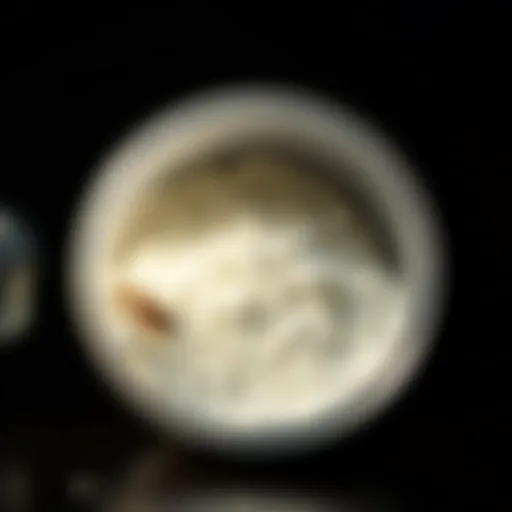Understanding Wasps: Behavior and Management in Yards

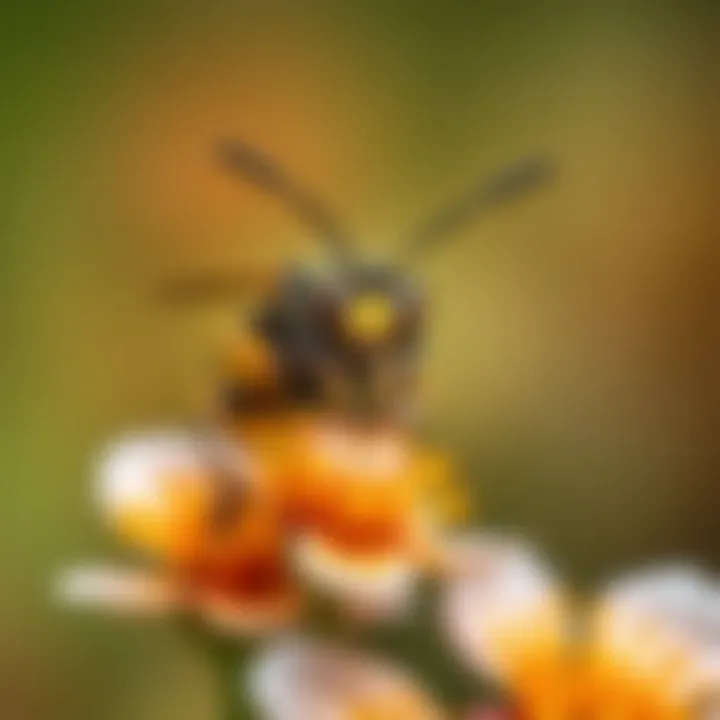
Intro
When you step into your yard, have you ever noticed the buzz of wasps nearby? While many view these creatures as mere nuisances, understanding their role in our ecosystem is essential for fostering peace between humans and these often-misjudged insects. Wasps, unlike bees, play many critical functions in nature. Their presence can signal an underlying environmental issue or indicate a healthy ecological balance.
In this article, we'll explore wasps further, examining their behavior, roles in nature, and ways to coexist harmoniously. With a keen eye on various eco-friendly management strategies, homeowners will learn how to differentiate between the beneficial and harmful species.
By the end of our discussion, readers will have gained valuable insights into the often overlooked yet pivotal part wasps play in our backyards.
Prologue to Wasps
Understanding wasps is crucial for anyone who spends time outdoors, especially homeowners and gardeners. These creatures often evoke a mix of fear and annoyance, yet they play indispensable roles in our ecosystems. Recognizing the significance of wasps can alter our perceptions, leading to better coexistence and reduced conflict.
One key element to grasp is that not all wasps are your garden’s nemeses. In fact, many wasps contribute positively by preying on pests that damage plants. Familiarizing oneself with these beneficial species can guide you in creating a balanced environment in your yard. Moreover, understanding their behaviors and breeding habits can spotlight seasonal peaks of activity, ensuring you’re prepared when they buzz around.
Considering wasps also brings variety into the conversation about yard management. How can we cultivate a space that minimizes unwarranted wasp encounters while benefiting from their ecological roles? One strategy involves making educated decisions regarding landscaping choices and food sources, as these factors can either attract or repel local wasp populations.
In summary, understanding wasps equips homeowners with the knowledge to navigate their habitats intelligently. This article will explore the distinct types of wasps, their vital ecological functions, and ways to manage interactions effectively. Armed with this understanding, readers can strike a balance between appreciating wasps' roles while keeping their homes and yards safe from unfavorable encounters.
Behavioral Patterns
Understanding the behavioral patterns of wasps is essential when managing their presence in our yards. Not only does this knowledge allow us to differentiate between the kinds of wasps we might encounter, but it also helps us to better appreciate their roles in the ecosystem. When we grasp these behaviors, we can make informed decisions that promote harmonious coexistence, while also protecting ourselves and our families from any potential threats they may pose.
Social vs. Solitary Wasps
Wasps generally fall into two categories: social and solitary, and distinguishing between the two can provide valuable insights for homeowners. Social wasps, like yellow jackets and paper wasps, live in colonies that can grow quite large during the warmer months. These colonies work collaboratively, sharing tasks such as foraging, nest building, and defense against intruders.
Conversely, solitary wasps, such as the mud dauber and the cicada killer, lead a more independent life. Each female solitary wasp typically builds her own nest, lays her eggs, and then departs without any further care for her brood. This solitary lifestyle can lead to more benign interactions with humans, as these wasps are less likely to exhibit aggressive behavior unless provoked.
Understanding these distinctions allows home dwellers to tailor their approaches. For example, if you notice a large nest that's buzzing with activity, you might be dealing with a social wasp colony. In this case, it might be best to keep your distance and consider preventive methods.
Foraging Habits and Nesting Preferences
Wasp foraging and nesting behaviors play a critical role in managing your yard. These insects are often attracted to food sources, particularly sugary substances and protein-rich food like meats, making backyard barbecues particularly enticing. It’s wise to keep food covered and dispose of trash regularly to minimize temptations.
Regarding nesting, social wasps prefer to build their homes in sheltered areas, such as eaves, attics, and dense vegetation, while solitary wasps tend to nest in soil or in pre-existing cavities like hollow stems. Understanding these preferences is crucial for homeowners:
- Identifying Locations: Knowing where these insects prefer to build their nests can help you take proactive measures, such as sealing entry points and removing potential nesting substrates.
- Timing: Wasps are generally more active in late summer and early fall as their colonies peak. A heads-up during these times can help you be cautious around common nesting spots.
In summary, delving into the behavioral patterns of wasps not only equips you with knowledge but also serves as a foundation for other sections of this guide. This understanding aids in prevention, control strategies, and respect for these insects' vital roles in the natural world.
"Awareness of their habits leads to better management and coexistence."
To further enhance your knowledge about wasp behavior, resources such as Wikipedia on Wasps and Britannica's detailed articles can provide additional insights.
Also, check community forums on platforms like Reddit for personal experiences and tips from fellow homeowners.
Ecological Roles of Wasps

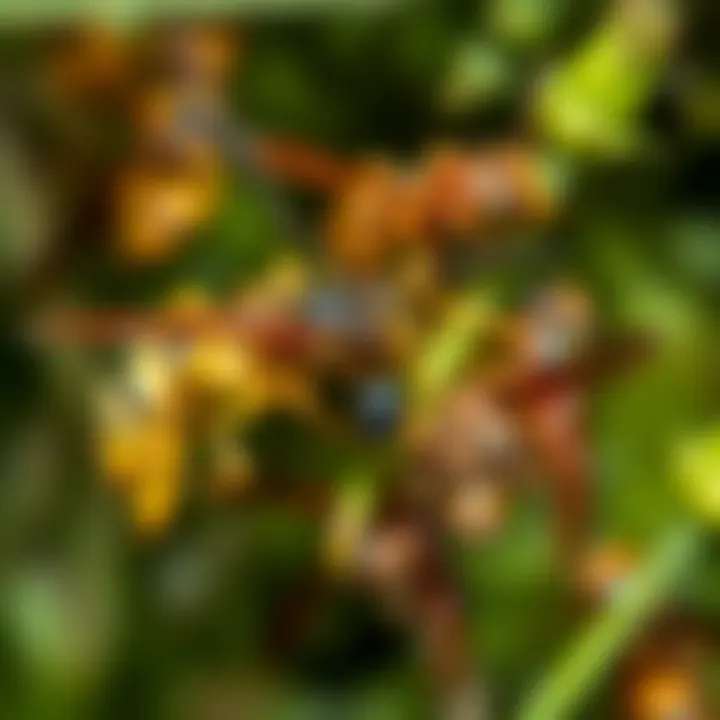
Wasps play a crucial role in maintaining ecological balance, yet many individuals remain unaware of their significance. By examining their ecological contributions, we discover that wasps are not merely pests invading our personal spaces. Instead, they offer substantial benefits to our environment, which we will explore in detail.
Pollination Contributions
Wasps contribute to pollination, though they may not be the first insects that come to mind. Many species of wasps are attracted to flowers, participating in a process that enhances plant reproduction. Unlike bees, who are often notorious for their pollination prowess, wasps can also transfer pollen from one bloom to another. This activity facilitates the growth of fruits and vegetables, which are essential for both wildlife and human consumption.
Here are some key aspects of wasp involvement in pollination:
- Diversity in Plants: Wasps help pollinate a wide variety of plants, including those that other pollinators may overlook. For instance, certain wasps are known to favor flowering herbs which attract them with their nectar. This behavior can lead to increased biodiversity in gardens.
- Resilience of Ecosystems: The presence of wasps in pollination networks leads to the resilience of ecosystems. Diverse plant life promotes healthy habitats for a variety of animals. Thus, by aiding in plant reproduction, wasps indirectly support local fauna.
- Support for Agriculture: Farmers benefit from wasps since they assist in pollination when various crops bloom. For achievements in farming, understanding and appreciating the role of wasps becomes paramount.
Overall, wasps indirectly enhance food security by ensuring the proliferation of essential crops. The interconnectedness of these environmental threads is vital for sustaining food webs.
Biological Control Agents
Beyond their role as pollinators, wasps serve as crucial biological control agents within ecosystems. This means that they help regulate pest populations, naturally keeping the balance of species in check, which can lessen the need for harmful pesticides in gardens and farms. Here's how they manage this critical function:
- Predatory Nature: Many wasps are predators of insects that can harm crops as well as ornamental plants. For example, species such as the Vespula and Polistes feast on caterpillars, aphids, and other detrimental pests. In this way, wasps become nature’s very own pest control service, which homeowners and gardeners can greatly benefit from.
- Larval Development: Some wasps lay their eggs inside other insects, which can help control pests in a targeted manner. As the larvae develop, they consume the host insect, reducing pest populations effectively and, more importantly, without chemical interventions.
- Natural Balance: This predation maintains a natural balance in the ecosystem, as it prevents any single species from dominating. A healthy predator-prey relationship ensures all creatures can thrive and contributes to biodiversity.
The loss of wasps can result in the overpopulation of certain pests, leading to increased damage in gardens and agriculture.
Identifying Problematic Wasps
Identifying problematic wasps is a crucial aspect of maintaining a safe and enjoyable outdoor environment. While many wasps play beneficial roles, some can become aggressive and pose risks to humans and pets. Understanding how to recognize these aggressive species and the signs of infestation can help homeowners take appropriate actions, ensuring a balanced coexistence with these insects.
Aggressive Species to Watch For
Not all wasps are created equal, and some species are known for their defensive behavior. Here are a few aggressive wasps to keep an eye out for in your yard:
- Yellowjackets: Often mistaken for bees, yellowjackets tend to nest in the ground or in wall voids. They're notorious for their aggressive foraging habits and will defend their nests vigorously, especially during late summer when food resources dwindle.
- Bald-faced Hornets: Despite their name, they are actually a type of wasp. These hornets build large, paper-like nests often found in trees or shrubs. They're particularly territorial and can swarm if they feel threatened.
- Paper Wasps: While generally less aggressive than yellowjackets, paper wasps can still deliver painful stings if they believe their nest is in danger. Their nests are open and umbrella-shaped, which can be a giveaway for identification.
Recognizing these species early can aid in avoiding unpleasant encounters and planning for safe management of any nests discovered in your yard.
Signs of Infestation
Being aware of signs that suggest a wasp infestation is vital for prompt action. Here are some key indicators:
- Increased Wasp Activity: Noticing more wasps than usual around your property, particularly near food sources or hidden corners, may suggest nearby nesting.
- Nests: Finding nests is the most apparent sign. Whether in trees, under eaves, or even in ground cavities, the presence of a nest indicates a potential problem.
- Buzzing Sounds: A distinct buzzing can often be heard when you're close to a wasp nest. If you hear this, it’s wise to exercise caution and stay clear.
- Damage to Property: Look for signs of chewing or paper-like debris from wasp nests, especially if it's near structural areas like eaves or attics.
Important: If you suspect an infestation, don’t attempt to remove the nest yourself without proper knowledge and protection. Wasps can defend their nests aggressively, leading to painful stings.
By being aware of these aggressive species and signs of infestation, you can act proactively and ensure your yard remains a safe haven for both you and your garden's ecosystem.
Preventing Wasp Encounters
In order to make the most of your outdoor space without the looming threat of wasp encounters, it's crucial to engage in preventive measures that can deter these insects from establishing a presence in your yard. Understanding wasp behavior and habitat preferences is key to achieving this. By employing effective management techniques and attentive home practices, you can create an environment that discourages wasps from becoming unwelcome guests.
Effective Yard Management Techniques

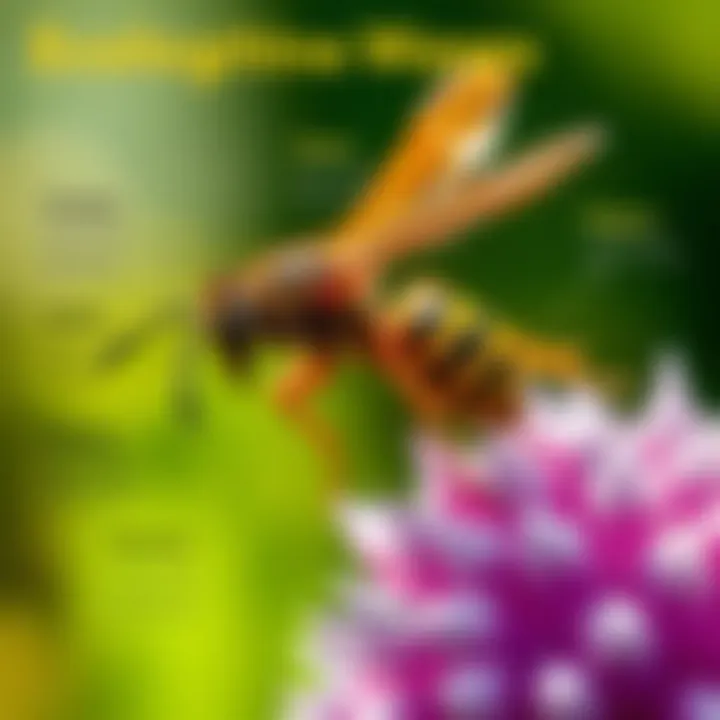
Maintaining a well-managed yard can significantly reduce the likelihood of attracting wasps. Here are some strategies that can help keep your outdoor habitat wasp-free:
- Regular Yard Cleanup: Wasps are attracted to food sources and overripe fruit. By maintaining a tidy yard and removing fallen fruit, food scraps, and any potential nesting materials, you can make your space less appealing.
- Plant Selection: Some plants and flowers attract wasps more than others. For instance, planting basil, peppermint, and marigold can deter wasps while attracting beneficial insects. Implementing a thoughtful planting strategy can help create an organic barrier against these pests.
- Trash Management: Always keep garbage bins tightly sealed. Wasps are voracious foragers and will seek out easy meals in uncovered trash. Using bins with a secure lid is a simple step that can keep them at bay.
- Limit Food Exposure: If you’re hosting an outdoor event, try to keep food and sweet beverages covered or indoors until ready to serve. Not leaving food out can restrict their ability to find nourishment near your home.
- Wasp Traps: Consider placing traps around your yard to catch any wandering wasps. Using sugar water in these traps can lure them away from your immediate area, reducing the chance of an encounter.
Home Maintenance Practices
In addition to yard management, maintaining your home is just as important when it comes to preventing wasps. A few thoughtful practices can make a world of difference:
- Seal Entry Points: Inspect your home for any cracks, gaps, or holes where wasps might enter. Areas around windows, doors, and even attic vents should be sealed with caulk to eliminate potential entry points.
- Regular Inspection: Engage in routine checks around your property to identify any early signs of wasp nests. If you find a small nest, it's often easier to handle before it becomes a larger problem.
- Roof and Gutter Care: Keeping your roof and gutters clean can minimize places for wasps to nest. Organic debris can provide an inviting environment for these insects, so regular maintenance can deter nesting efforts.
- Proper Lighting: Installing yellow or sodium vapor lights around your porch can help, since these lights are less attractive to wasps than traditional white lighting.
Effective prevention starts with diligence. By combining good yard practices with proper home care, you can create an environment that's less favorable for wasps.
Implementing these strategies not only protects you from unwanted wasps but also enhances the overall enjoyment of your yard, allowing you to benefit from your outdoor space without worry.
Eco-Friendly Wasp Control
Eco-friendly wasp control is crucial in today’s environmentally-conscious world, where more people are seeking sustainable solutions for common household problems. Instead of resorting to harsh chemicals that can harm beneficial insects, the focus is shifting towards methods that ensure a balance between protecting our homes and nurturing our ecosystem. Understanding these eco-friendly approaches not only helps in minimizing the ecological footprint but also fosters a safer environment for children and pets.
By choosing eco-friendly methods, homeowners can effectively manage wasp populations while preserving other helpful creatures that play beneficial roles in the garden. This is a responsible way to handle situations involving these insects. Many might think wasps are simply nuisances, but in reality, they contribute both to pest control and pollination.
Natural Repellents and Deterrents
Using natural repellents can significantly help in discouraging wasps from taking up residence near your home. Here are some effective strategies:
- Peppermint Oil: Wasps dislike the smell of peppermint. Mixing a few drops of peppermint oil with water in a spray bottle can create a potent natural repellent. Spraying this solution around areas that attract wasps can deter them effectively.
- Vinegar and Water Mix: A combination of vinegar and water can work wonders. Not only does the sharp scent repel them, but placing this mixture in a trap can also attract and catch the pests.
- Citrus Scents: Wasps have a natural aversion to citrus. Rubbing lemon or orange peels around the outdoor dining area or placing citrus peels in the garden could keep these insects at bay.
- Cayenne Pepper Spray: A strong solution that mixes cayenne pepper with water can also function as a natural deterrent when sprayed around potential nesting areas.
Using these methods can considerably reduce the likelihood of unwanted encounters without harming the ecosystem. However, it is essential to apply these deterrents consistently and to consider wind patterns, as they can affect the efficacy of the scents.
Humane Removal Techniques
When wasps become intrusive, humane removal techniques provide effective solutions without resorting to lethal measures. This approach requires a careful touch and consideration for the insect's well-being:
- Wasp Traps: Constructing traps using non-toxic materials, where wasps enter but cannot escape, allows for humane capture. You might use a simple bottle trap with bait like sugar water to draw them in. Ensure to release the wasps away from your home, ideally in an area where they'll pose minimal risk.
- Nest Relocation: If a nest is discovered, hiring a professional that understands safe relocation strategies can be beneficial. They can carefully extract the nest and place it in a more appropriate location, allowing the wasps to thrive without disturbing humans.
- Timing Matters: The best time to manage wasps is at dusk or dawn when they are less active. Approaching them then can reduce the chances of agitation.
These techniques advocate for coexistence rather than eradication, showing a commitment to eco-friendly principles. By employing these methods, you not only contribute to a healthier environment but also cultivate an understanding of wasps as essential members of our ecosystem rather than mere pests.
"To nurture nature, we must learn the art of coexistence with all creatures, including wasps."
For further information on humane pest control practices, resources such as the U.S. Environmental Protection Agency or the Humane Society can provide additional insights.
When to Seek Professional Help
Addressing a wasp issue in your yard can become overwhelming, especially when it escalates beyond simple removal techniques. Understanding when to call in the professionals is crucial for ensuring safety and effectiveness in managing these insects. The right intervention can save not just your sanity, but also potential damage and injuries.
Recognizing Serious Infestations
A major indicator that it's time to enlist professional help is the size and complexity of the wasp nest. If you observe clusters of wasps buzzing about, or if a nest is larger than a basketball, it's likely that you're dealing with a serious infestation. Here are some signs you should watch out for:
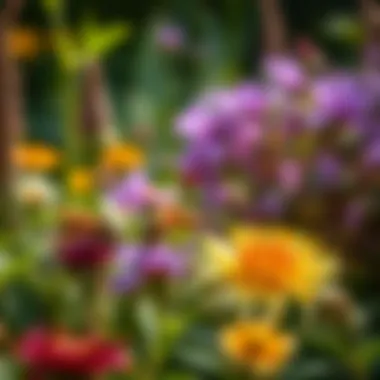

- Increased Activity: If you notice a significant uptick in wasp activity around your yard or home, especially during late summer when wasps are more aggressive.
- Aggressive Behavior: If you find that the wasps are unrelenting and tend to swarm when approached, this could indicate that you've intruded into their territory.
- Nesting Locations: If wasps have established nests in tricky spots, like inside wall cavities, under eaves, or in attics, this complicates removal significantly.
Although many wasps are beneficial, their presence can quickly become problematic if the situation gets out of hand. An infestation not only poses health risks due to potential stings but can also disrupt your outdoor activities and peace of mind.
Consider this: A wasp sting can trigger severe allergic reactions. If anyone in your household has a known allergy, taking swift action becomes even more urgent.
Choosing the Right Pest Control Service
Once you've acknowledged that a professional touch is needed, selecting the right pest control service is essential. Here are some considerations to guide your choice:
- Certifications and Licenses: Always check the qualifications of the service. A reputable pest control expert should be licensed and certified to operate in your area.
- Experience with Wasps: Not all pest control services have significant experience dealing with wasps specifically. Look for providers who specialize in wasp removal to ensure effectiveness.
- Eco-Friendly Options: If you're concerned about the environmental impact, inquire if they offer eco-friendly solutions. Some services use less harsh chemicals or natural deterrents to manage wasp populations.
- Customer Reviews and Testimonials: Take a peek at online reviews or ask for referrals. A company with positive feedback is often more reliable.
By carefully assessing your situation and selecting a capable pest control service, you can manage wasp concerns with greater confidence, ensuring a safer environment for your family.
Myths and Misconceptions
Understanding wasps conjures a flurry of myths and misunderstandings that often cloud the reality of these insects. Misconceptions can lead to unwarranted fear or unnecessary extermination, impacting both the ecosystem and our living spaces. It is crucial to identify these myths and understand why they persist. By dispelling common beliefs, we empower ourselves to make informed decisions that respect both human needs and ecological balance. This section aims to clarify prevalent myths surrounding wasps, enhancing our understanding of their place in our environments.
Debunking Common Myths
Many people view wasps as nothing more than aggressive pests, but this narrative is significantly distorted. Below are several myths encountered regularly:
- All Wasps are Aggressive: While it’s true some species can be aggressive when threatened, many wasps will only sting if they feel their nest or young are in danger. In most cases, they are more interested in gathering food or defending their homes than seeking trouble.
- Wasps Only Sting in Defense: The reality is that certain species, such as the yellow jacket, may become defensive due to food competition as well. They might be more inclined to sting when there’s sweet food around.
- Wasps Destroy Gardens: In fact, many wasps are beneficial in gardens. They often prey on pests like caterpillars and aphids. They assist in pest control, meaning they can help keep your plants healthy while you enjoy the fruits of your labor.
- Wasp Nests are Always Dangerous: Ignoring a small nest doesn’t pose a significant risk if left undisturbed, as long as you respect their space. Encounters can typically be avoided by recognizing their habitats and behavior.
- All Wasps Produce Honey: Unlike bees, which are famous for their honey production, most wasps do not store honey. Instead, they feed on nectar and other insects.
Debunking these myths opens our eyes to the various roles wasps play in our ecosystems. They are misunderstood creatures, often more beneficial than harmful.
Understanding Wasp Behavior in Context
Wasp behavior is frequently viewed through a lens of fear and misunderstanding, shaped by sensationalized stories rather than facts. Gaining insight into their behavior requires observing them within their natural context.
- Social Structure: When discussing social wasps, like the paper wasp, it’s interesting to note how their colonies function. They exhibit complex social hierarchies, with each member playing a vital role - from the queen to the workers. Understanding this dynamic can lead to a greater appreciation of their existence.
- Foraging Patterns: Wasps are often spotted hunting or searching for sweet foods. Their foraging rituals vary by species, showing adaptability and a keen sense for locating nourishment. This behavior is a crucial component of their ecological role, helping to balance insect populations within gardens and yards.
- Seasonal Changes: As seasons change, so do their behaviors. In spring, they are focused on building nests and finding mates, while in late summer, they might act more defensively as food sources dwindle. Knowing this can reduce panic when wasps seem more aggressive at different times of the year.
Understanding wasps requires considering their idiosyncrasies in behavior, habitat, and life cycle. By contextualizing these behaviors, we can significantly reduce fear and promote a harmonious coexistence.
Grasping the nuances of wasp behavior and dispelling myths empowers homeowners to coexist peacefully with these insects while also reaping benefits that comes from their presence.
Concluding Thoughts
Winding down the conversation on wasps, it’s crucial to understand their multifaceted role in our backyards. As bothersome as they may seem at times, wasps are more than mere nuisances; they carry ecological significance that deserves our attention. When considering the best ways to engage with these creatures, it's about finding common ground—after all, nature often thrives on balance, and so should we in our shared spaces.
Balancing Human-Wasp Coexistence
The key to a harmonious relationship with wasps lies in recognition and respect. Not every buzz or sting spells trouble. Many species are vital to pollination and pest control, helping keep garden ecosystems healthy. Here are a few practical ways to coexist peacefully:
- Respect their habitat: If you notice nests forming, try to monitor from a distance. Wasps will usually move on once the season changes.
- Limit attractants: Keep food sealed when outdoors. A half-finished soda can or an open container can attract these insects like moths to a flame.
- Educate your family: Knowledge about wasp behavior can prevent unnecessary panic. Informing children that wasps only sting when provoked may help ease tensions.
By following these guidelines, you not only protect yourself but also contribute to a balanced ecosystem.
Future Considerations for Pest Management
When thinking about pest management, approaches must be sustainable and reflect an ever-evolving understanding of wasps. A shift towards more eco-friendly methods represents a growing trend, aiming to harmonize human needs with environmental responsibilities. Some considerations include:
- Integrating natural repellents: Utilizing substances like peppermint oil or vinegar can deter wasps in a way that doesn’t harm other beneficial insects.
- Engaging with local experts: Consult specialists who focus on humane wasp management strategies. Their insight could offer alternative perspectives and methods that wouldn’t disrupt the ecological balance.
- Community awareness programs: Initiatives that educate neighbors about minimizing attractants and handling nests can spread awareness and reduce fear.
The road ahead in pest management leads to innovations that prioritize both safety and nature. As we navigate our responsibilities, it’s clear that maintaining coexistence demands a blend of respect, awareness, and adaptability. Understanding wasps isn’t just about dealing with problems as they arise; it’s about fostering a community where human and insect life can thrive together.

